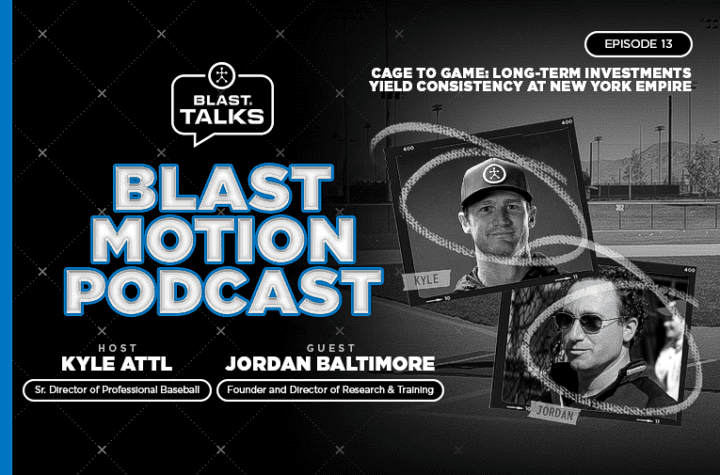
It has been said that in life, timing is everything. And if you’re a golfer, you know that this is especially true when it comes to your golf swing – particularly when it comes to your putting stroke.
But just what is timing all about in golf, exactly? And why is it so important to a successful putting stroke on the green?
We recently spoke with Blast Motion Founder Michael Bentley and Lead Biomechanist Patrick Cherveny to learn more. In addition to creating Blast Motion and helping grow Blast Golf, Bentley also has extensive experience as a PGA instructor and former international tour player.
Applying the FORCE.
“If we look at timing, as just an element of force, we’re really looking at how a golfer applies force to the putting stroke,” explains Bentley. “We break it down into the specific elements including timing, length and speed. By timing the back stroke time and the forward stroke time, we can see how well or how efficient the golfer is moving during their game on the course, and on the practice putting green.”
This element of timing is so vital to a successful golfer’s performance that Bentley made sure it was a primary focus of everything Blast Motion did upon the company’s founding.
Finding the RIGHT Time.
It’s one thing to understand the ins and outs of timing in a golf swing or putting stroke. It’s another to know what constitutes ideal timing – and how to attain it. By compiling massive amounts of data on numerous golfers, Blast Golf has been able to come closer to putting an actual number on the value of timing.
“By collecting so many strokes of all the best players in the world, as well as the amateur golfers, we can see big changes in those players,” explains Bentley. “The best players in the world are able to keep their timing variances down within a few hundredths of a second, where beginners are maybe as high as sixth, seventh, tenths of a second.”
“From a timing standpoint, it relates more to the motor control process,” adds Cherveny. “Michael’s referring to force, torque, those type of movements. While the golfer doesn’t have as much knowledge of how to control force, timing makes more sense to them, so it’s an easier way for them to replicate it. They’re always going to be differences between different skill levels, but it’s also something that anyone can actually work at – through feedback and repetition – to actually increase that capability.”
It’s ALWAYS the Right Time for BLAST.
One way a golfer can get that feedback and repetition and increase his or her capabilities is through the use of Blast Golf technology. But just how does Blast help a golfer build and maintain that ideal timing?
“The best players in the world have figured it out through thousands and thousands of motions. The beginning golfer doesn’t have that much time to spend on honing his skill, so we’re able to give him a clock that he can carry with him anywhere he wants to go. With a portable clock, you can get really tight with those variances – and you’re going to make a lot more putts.”
That Blast-manufactured “clock” Bentley references is much more than a clock, however. Its technical name is Blast Golf 360 – and it’s the industry’s most accurate sensor and mobile app available. It has been carefully designed to capture every action and stroke metric, then deliver unique analysis and insights. It also can provide the user with drills designed to improve and refine your timing.
It’s also incredibly easy to apply and implement. Just attach your sensor to the included grip attachment, place that attachment onto the butt of your club, and sync it up with the companion smartphone app.Then simply start swinging. Learning. Improving. The end result? You start making more putts.
When it comes to perfecting timing in your golf swing or putting stroke, there are included specific drills you can practice and work on.
“Go out and hit a three-foot putt, a six-foot putt and a 30-foot putt,” says Bentley. “Forget path attack or face angle, forget all those things. Keep it simple. Get timing first, get consistent with it, and then you’ll start seeing the other elements start to be constrained. And if you constrain those other elements, you will increase my performance.”
This approach works for golfers of all levels – including decorated PGA Tour professionals (and Blast Golf Athlete) like Jeff Sluman. Thanks in large part to his work with Blast Golf technology. Sluman improved from 33rd place on the PGA Champions Tour in putting in 2015 to the very top of the list during the 2016 PGA Champions season.
Use Blast in ALL Areas of Your Game.
It’s pretty clear that refining the timing of your swing can make a huge difference in your golf game – starting with your putting stroke. But improving your timing can impact your overall golf game
While it might all begin with putting, it doesn’t end there.
“We started the story very easy with putting, because it’s a simple concept,” says Bentley. “Now I can make it more complex as I go into the full swing, and look at those elements. You have a guy like a Brad Faxon who’s phenomenal with the short game – he’s not as strong with his driver, but he is one of the best at the short game. And is his timing different with his driver than his wedges and putter? Yes. And then you have other guys that are phenomenal with the driver, but not so good with the putter. Rory McIlroy is a great example. Look what Rory’s been doing with his ball striking for a long time. And look what he’s been doing with his putter, and you’ll see those signatures. The great news is all of these players are working on their weaknesses and making them strengths with the Blast feedback. The stories are there.”
Cherveny agrees. Timing really is everything.
When an athlete struggles mechanically, they often get caught in a paralysis by analysis state where they focus on every small detail of their swing. This often times results in even worse performance, especially in their ability to perform an action in a repeatable manner. “A lot of times it’s innate from the athlete, because they want to try and control it even more – but that actually leads to increased variance. There’s a lot going on in terms of what the athlete’s trying to change. But the timing and the tempo of the swing really kind of drive home the end goal, that it is such a simple concept that you can actually train to. And that’s why it’s so powerful.”













